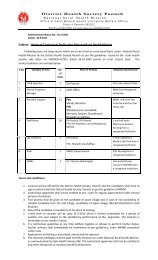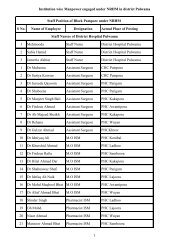Guidelines for Setting Up Blood Storage Centres - NRHM Tripura
Guidelines for Setting Up Blood Storage Centres - NRHM Tripura
Guidelines for Setting Up Blood Storage Centres - NRHM Tripura
Create successful ePaper yourself
Turn your PDF publications into a flip-book with our unique Google optimized e-Paper software.
Foreword<br />
It is estimated that <strong>for</strong> every 100,000 live births, 407 pregnant women die every year in India due to causes related to<br />
pregnancy and childbirth. The major causes of these deaths have been identified as anaemia, hemorrhage (both ante<br />
and post partum), toxemia (Hypertension during pregnancy), obstructed labour, puerperal sepsis (infections after<br />
delivery) and unsafe abortions. Over the years, ef<strong>for</strong>ts to reduce maternal mortality and morbidity have included<br />
providing family planning services, improving essential obstetric care including antenatal care, safe/institutional<br />
deliveries, prophylaxis and treatment of anaemia and postnatal care and emergency obstetric care.<br />
Complications associated with pregnancies are not always predictable. There<strong>for</strong>e, provision of emergency obstetric<br />
care as close to the community as possible was envisaged under the CSSM Programme by setting up First Referral<br />
Units at the community health centres/sub-district level hospitals. However, most of the identified FRUs could not<br />
become fully operational due to lack of skilled manpower, particularly anesthetists and gynecologists, adequate<br />
infrastructure, medicines and blood banking facilities. Non-availability of blood storage/transfusion facilities at the first<br />
referral units has thus been a major constraint in provision of emergency obstetric care services. However, now that the<br />
Drug and Cosmetics Rules have been amended, it would be possible to set up blood storage centres at the sub-district<br />
level health facilities without going through the elaborate exercise of setting up <strong>Blood</strong> Banks in all these places.<br />
A core group of experts with Dr (Mrs.) Ira Ray, <strong>for</strong>mer Additional Director General of Health Services, Government of<br />
India, as the Chairperson and Dr. V. K. Manchanda, Deputy Director General (Maternal Health/Training), as Convener,<br />
was constituted to finalise the <strong>Guidelines</strong> <strong>for</strong> setting up of blood storage centres at first referral level units.<br />
I am happy to note that the group has not only been able to put together the guidelines <strong>for</strong> setting up the blood storage<br />
facilities but also drawn up the Standard Operating Protocol and the Clinician’s <strong>Guidelines</strong> <strong>for</strong> Appropriate use of<br />
blood and blood products. For the benefit of administrators, clinicians and other health functionaries, the three<br />
documents are being put together in one volume.<br />
I would like to acknowledge here the ef<strong>for</strong>ts put in by the members of the core group. I am sure this ef<strong>for</strong>t will go a long<br />
way not only in planning and setting up of the services, but also in ensuring uni<strong>for</strong>m and good quality service at these<br />
blood storage centres.<br />
10th June, 2003<br />
(J. V. R. Prasada Rao)<br />
Secretary<br />
Department of Family Welfare<br />
Ministry of Health & Family Welfare<br />
Government of India<br />
I

















